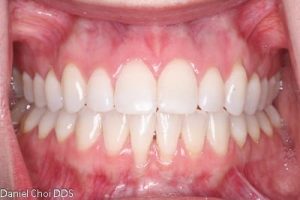Gum Grafting Plano Texas
Do some of your teeth look longer than they used to, or you have a high sensitivity to hot and cold food or beverages? Then you may be experiencing gum recession or root exposure. Gum recession often sneaks up on patients because it occurs so gradually. We see patients from Plano, Texas, and the surrounding area for gum recession treatment at our dental surgery center.
A common cause of gum recession is gum disease. Some factors that can increase your chances of initial infection include bad oral hygiene, hormone changes, diabetes, and genetic makeup. Another thing to keep in mind is that the CDC has reported that smokers are four times more likely to experience gum disease. In fact, almost every type of tobacco increases your chances of getting gum disease.
Other causes for gum recession include rough brushing, clenching or grinding your teeth, and forces caused by misaligned teeth. Also, note that having a lip or tongue piercing can irritate and degrade the gums over time.
Before Gum Grafting

After Gum Grafting

Treating receding gums
If your receding gums are caused by gum disease and excessive tartar buildup, we recommend that you get a scaling and root planing (SNR) as an initial step. This deep cleaning removes bacteria and plaque that has built up, along with any tartar buildup on your roots or teeth. This will help heal the gums and prevent further recession. If you have some more serious gum recession, you can also consider getting gum graft surgery. This surgery not only heals the recession already present but also prevents more from happening in the future. Just to be safe, you should always be watching for early signs of gum disease and gum recession. These can include swollen or red gums and persistent bad breath. This way, you can catch the disease early before it gets too bad and requires extensive care.
Types of gum grafts
There are two types of gum grafts that are typically found in practice by periodontists.
Connective Tissue Grafts. Connective tissue grafts are the most common grafting procedure performed. This method takes tissue from the underlayer of the roof of your mouth and uses it to cover up exposed root areas in the gums.
Free Gingival Grafts. Free gingival grafts are very similar, but the tissue is directly taken from the palate. This type of procedure is less common due to the tissue being taken directly from the palate, it leaves the area exposed and increases the risk for pain.
Recovery from a gum graft
Your dentist can give you further instructions on how to care for your gums after the surgery including diet, exercise, and medication information. It is important that you don’t floss or brush the area where the gum grafting took place until it has healed. To help control the cleanliness of the mouth and to reduce chances of getting an infection, you will be given instructions on how to use a special mouthwash. You may be put on an antibiotic to further prevent infections.
For the few weeks after the gum grafting surgery, you need to eat soft, cool foods. Some good examples include pasta, eggs, Jell-O, steamed vegetables, yogurt, and ice cream. The level of pain you experience after the surgery will depend greatly on what type of gum grafting was done. Prescription pain medication or over-the-counter anti-inflammatory medications can be used to provide extra comfort and pain relief following the surgery. It can take a few weeks for your mouth to make a full recovery, but you will be up and back to your normal routine in no time!
Gum Grafting Specialist
Here at North Texas Dental Surgery in Plano, Texas, our board-certified specialists are excited to transform your smile. We offer the highest quality of service at the most affordable price. Our office is in-network with a majority of dental PPO insurance plans and we offer third-party financing options. Come experience the best dentistry has to offer with IV sedation options available. Take a nap while your treatment is being completed. Why not come in for your free consultation and 3D scan today?




